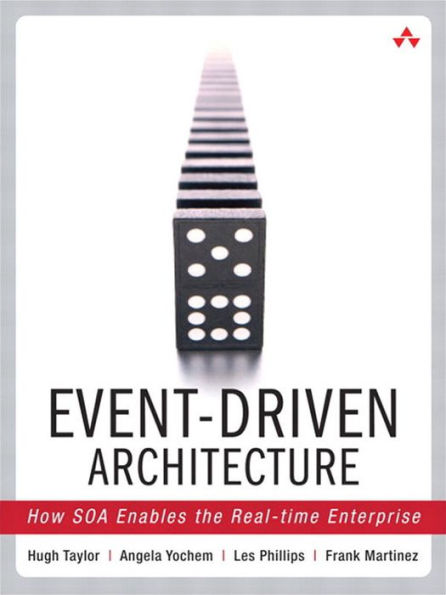Improving Business Agility with EDA
Going beyond SOA, enterprises can gain even greater agility by implementing event-driven architectures (EDAs) that automatically detect and react to significant business events. However, EDA planning and deployment is complex, and even experienced SOA architects and developers need expert guidance. In Event-Driven Architecture, four leading IT innovators present both the theory of EDA and practical, step-by-step guidance to implementing it successfully.
The authors first establish a thorough and workable definition of EDA and explore how EDA can help solve many of today’s most difficult business and IT challenges. You’ll learn how EDAs work, what they can do today, and what they might be able to do as they mature. You’ll learn how to determine whether an EDA approach makes sense in your environment and how to overcome the difficult interoperability and integration issues associated with successful deployment. Finally, the authors present chapter-length case studies demonstrating how both full and partial EDA implementations can deliver exceptional business value. Coverage includes
- How SOA and Web services can power event-driven architectures
- The role of SOA infrastructure, governance, and security in EDA environments
- EDA core components: event consumers and producers, message backbones, Web service transport, and more
- EDA patterns, including simple event processing, event stream processing, and complex event processing
- Designing flexible stateless events that can respond to unpredictable customers, suppliers, and business partners
- Addressing technical and business challenges such as project management and communication
- EDA at work: real-world applications across multiple verticals
Hugh Taylor is a social software evangelist for IBM Lotus Software. He coauthored Understanding Enterprise SOA and has written extensively on Web services and SOA. He holds an MBA from Harvard Business School. Angela Yochem is an executive in a multinational technology company and is a recognized thought leader in architecture and large-scale technology management. Les Phillips, VP, enterprise architecture, at SunTrust Banks Inc., is responsible for defining the strategic and business IT foundation for many areas of the enterprise. Frank Martinez, EVP, product strategy, at SOA Software, is a recognized expert on distributed, enterprise application, and infrastructure platforms. He has served as senior operating executive for several venture-backed firms and helped build Intershop Communications into a multibillion-dollar public company.
Improving Business Agility with EDA
Going beyond SOA, enterprises can gain even greater agility by implementing event-driven architectures (EDAs) that automatically detect and react to significant business events. However, EDA planning and deployment is complex, and even experienced SOA architects and developers need expert guidance. In Event-Driven Architecture, four leading IT innovators present both the theory of EDA and practical, step-by-step guidance to implementing it successfully.
The authors first establish a thorough and workable definition of EDA and explore how EDA can help solve many of today’s most difficult business and IT challenges. You’ll learn how EDAs work, what they can do today, and what they might be able to do as they mature. You’ll learn how to determine whether an EDA approach makes sense in your environment and how to overcome the difficult interoperability and integration issues associated with successful deployment. Finally, the authors present chapter-length case studies demonstrating how both full and partial EDA implementations can deliver exceptional business value. Coverage includes
- How SOA and Web services can power event-driven architectures
- The role of SOA infrastructure, governance, and security in EDA environments
- EDA core components: event consumers and producers, message backbones, Web service transport, and more
- EDA patterns, including simple event processing, event stream processing, and complex event processing
- Designing flexible stateless events that can respond to unpredictable customers, suppliers, and business partners
- Addressing technical and business challenges such as project management and communication
- EDA at work: real-world applications across multiple verticals
Hugh Taylor is a social software evangelist for IBM Lotus Software. He coauthored Understanding Enterprise SOA and has written extensively on Web services and SOA. He holds an MBA from Harvard Business School. Angela Yochem is an executive in a multinational technology company and is a recognized thought leader in architecture and large-scale technology management. Les Phillips, VP, enterprise architecture, at SunTrust Banks Inc., is responsible for defining the strategic and business IT foundation for many areas of the enterprise. Frank Martinez, EVP, product strategy, at SOA Software, is a recognized expert on distributed, enterprise application, and infrastructure platforms. He has served as senior operating executive for several venture-backed firms and helped build Intershop Communications into a multibillion-dollar public company.

Event-Driven Architecture: How SOA Enables the Real-Time Enterprise
336
Event-Driven Architecture: How SOA Enables the Real-Time Enterprise
336
Product Details
| ISBN-13: | 9780321635150 |
|---|---|
| Publisher: | Pearson Education |
| Publication date: | 02/17/2009 |
| Sold by: | Barnes & Noble |
| Format: | eBook |
| Pages: | 336 |
| File size: | 4 MB |
| Age Range: | 18 Years |
